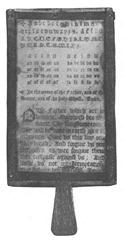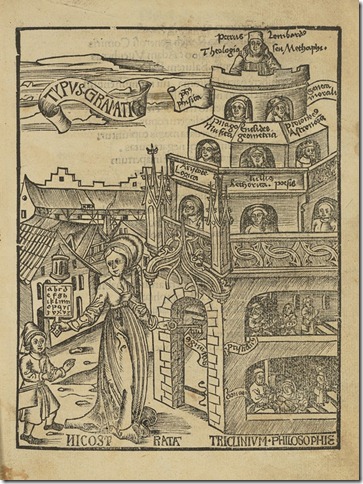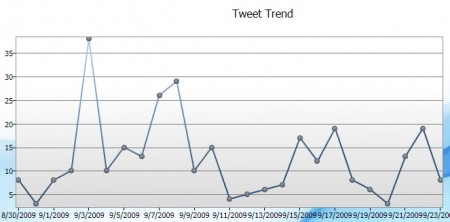 The hornbook was not a book, but a small wooden board with a handle. A sheet of vellum inscribed with a lesson—typically the alphabet and the Lord’s Prayer—was attached to one side and covered by a thin, transparent layer of horn or mica. Historians don’t know much about hornbooks, other than they were important tools for primary education in the 16th and 17th centuries in England, Germany, Holland, and by way of the Puritans, the American colonies.
The hornbook was not a book, but a small wooden board with a handle. A sheet of vellum inscribed with a lesson—typically the alphabet and the Lord’s Prayer—was attached to one side and covered by a thin, transparent layer of horn or mica. Historians don’t know much about hornbooks, other than they were important tools for primary education in the 16th and 17th centuries in England, Germany, Holland, and by way of the Puritans, the American colonies.
Shakespeare mentions a “Hornebook” in Love’s Labor Lost, and it’s not unlikely that Shakespeare himself first learned his letters on a hornbook. In 1916 the book antiquarian George Arthur Plimpton, whose knowledge of the hornbook has never been surpassed, pointed to a woodcut in Gregor Reisch’s magisterial Margarita Philosophica (1503) to illustrate the fundamental role of the hornbook in the early modern curriculum:

A boy stands outside the Tower of Knowledge (each level representing progressively heightened domains of learning, from the grammar of Donatus and Priscian on the lower levels, to the science and philosophy of Cicero, Aristotle, Seneca and Pliny on the upper levels). To enter the Tower of Knowledge the boy need only accept the hornbook from his teacher and master it. As Plimpton puts it, the hornbook was “the key to unlock the treasures of learning” (4).
But the hornbook wasn’t simply a metaphorical key. It answered a very real concern of material culture at the time. Parchment, and later, paper, was simply too costly to be put in the hands of young learners. With its vellum primer protected like a laminated lesson, the sturdy hornbook was a hardware solution to a social problem. On some hornbooks the vellum could slide out from underneath the translucent horn and be replaced by other lessons. The hornbook in this way was a kind of 17th century iPad. Much more durable than paper, hornbooks were apparently passed down between students, sibling to sibling, generation to generation.
What’s surprising about hornbooks, given their durability and symbolic as well as literal value in early modern education, is how few have survived into the 20th and 21st centuries. Plimpton lamented in 1916 that “the British Museum has only three, and the Bodleian Library at Oxford one” (5). In fact, the most exhaustive collection of hornbooks is probably Plimpton’s own collection, amassed over years and now housed at Columbia University.
A Digital Hornbook
I’ve been thinking about hornbooks lately. Especially after THATCamp Piedmont, an unconference I helped to organize at Davidson College on May 5, 2012. In particular, I’ve been mulling over a session my friend and ProfHacker colleague George Williams organized on Brainstorming a “Digital Humanities Creator Stick.” George’s idea was focused and powerful:
What applications and documents might be included on a “Digital Humanities Creator Stick,” a collection of tools that could fit on a USB flash drive, allowing students, teachers, researchers, and anyone else to work on digital humanities projects. An individual would plug the stick into any computer and instantly have access to what she needs to get work done. Unplug the stick and she takes those tools with her.
In my mind I’ve been comparing George’s digital humanities creator stick (or DH jump drive, as Roger Whitson described it) to a hornbook. Like the hornbook in Reisch’s Tower of Knowledge, it provides entry into a world that might otherwise be closed to the newcomer. Even the paddle shape of the hornbook resembles a USB flash drive.
Likening a digital humanities jump drive to an 17th century hornbook requires a certain amount of historical and technological blindness, but I’d like to entertain the comparison briefly, in order to find out if the fate of the hornbook gives us any insight into a similar kind of tool for the digital humanities. The hornbook arose during a particular historical moment to address a particular social problem. I called it a piece of hardware earlier, but really, it was a platform, in much the same way the Nintendo Wii is a platform. The wooden board itself and the translucent horn overlay were the hardware, while the vellum or paper lesson was the software. As platform studies has shown, however, hardware and software alone do not comprise the sum total of any technological platform. Use and social context are as much a part of the platform as the physical object itself.
And yet we don’t actually know what students did with their hornbooks or how they used them. We have glimpses—a few illustrations, some mentions in literature, a handful of advertisements. But the full scope of how teachers and students had meaningful (or not so meaningful) interactions with the tool and in what environments is lost to us. We simply don’t know.
This missing social element of the hornbook makes me think of the DH creator stick. The THATCamp Piedmont session prompted a lively discussion. But I know George was initially frustrated with the direction of this conversation, which trended toward the abstract, ranging from questions about the digital divide to issues surrounding digital fluency. George had wanted—and the collaborative notes generated during the session reflect this—to focus more concretely on assembling a definite list of tools and documentation that could be put on a USB flash drive. At one point in the session (probably after I had introduced a Lego versus Ikea approach to getting stated in the digital humanities), George compared assembling a digital humanities toolkit to a homeowner putting together his or her first toolbox. You know you need a hammer, a screwdriver, and a few other common tools. Before you head to the hardware store you don’t need to philosophize about the nature of home itself. A homeowner doesn’t ask, What is a home? A homeowner goes out and buys a hammer.
I appreciated the analogy and George’s efforts to ground the discussion. I’m not so sure, though, that we in the digital humanities have figured out what our “home” is, much less what our essential tools are. I am not ready to foreclose the discussion about what we ought to be doing with our tools, which surely would influence what those tools are. I am not ready, to use the hornbook as a metaphor, to affix a standard lesson underneath a protective laminate of horn.
And to be sure, I know very few digital humanists who would argue differently. I doubt that anyone who was in the THATCamp session would want to declare this or that set of tools to be the canonical tools of DH, or this or that set of practices to be the only valid approach to digital humanities work. This openness is one way a digital hornbook differs from the historical hornbook, which was clearly meant to be the first step in a rigidly prescribed way of thinking. I can think of some humanists a hornbook might appeal to in this regard, but no digital humanists.
A digital hornbook would avoid the monologic authority of a historical hornbook by not only including a variety of tools but also including a range of documentation and pedagogical material. George mentioned several times in the session that while we had compiled a great list of tools, we hadn’t thought about the kind of guides or tutorials that should be included on the DH stick. He’s right. It wasn’t until toward the end of the session that we added some guides—mostly standard, official documentation of the various tools and services on the list. And then, at last, a few more substantive, scholarly perspectives on the digital humanities found their way onto the ideal DH Creator Stick: A Companion to Digital Humanities, Hacking the Academy, and Debates in the Digital Humanities.
It’s the presence of these last two texts in particular that finally make the DH Creator Stick more than an inert catalog of portable apps. Hacking the Academy and Debates in the Digital Humanities fill a role that none of the other tools or guides on the proposed list do. They fill an absence that mirrors the unknown social life of the hornbook, for they tell us about the social life of the digital humanities. They model the digital humanities in action. And they do so by presenting a multiplicity of voices, a range of concerns, and most important to broadening the digital humanities audience, an ongoing and reiterative invitation to students, teachers, and young scholars to consider the impact of the digital on the questions that humanists ask of the world.
It’s crucial to have documents like these available for students and novice practitioners, but I would go farther. What we most need to include on a digital hornbook for newcomers to the digital humanities is precisely that which can never be distilled digitally. It’s an attitude, an ethos. Perhaps the closest we might come is dumping the entire contents of Day of DH onto the flash drive, all four years of blog posts about what people actually do during their daily work. This material might give aspiring digital humanists (not to mention humanists) a better entry point into the discipline than any set of tools or tutorials. Even then, though, the diverse principles that inspire us may not shine through. I’ve labeled my own approach deformative humanities, but there are many other ways to conceive of the spirit that motivates digital humanists. In any case, the real challenge we face is capturing and relaying this attitude. A 4GB (or 8GB or 16GB or 32GB) flash drive can hold a fantastic number of applications and documents, but it’s a capacity that may mislead us into thinking that the DH jump stick would be a powerful tool in and of itself. The prescribed lesson on a hornbook teaches us very little, apart from telling us what society deemed necessary to enter the Tower of Knowledge. The contents of a flash drive similarly teach us very little, apart from demonstrating what a group of people—we digital humanists—valued at a certain moment in the early 21st century. Centuries from now I would not want a media archaeologist bemoaning the utter lack of context surrounding a flash drive housed in Special Collections that was obliquely labeled “DH Creator Stick.” The digital humanities is people and practices, not tools and documentation. The real question is, can our tools and documentation convey this?
Works Cited
Plimpton, George Arthur. The Hornbook and Its Use in America. Worcester, MA: American Antiquarian Society, 1916.
Reisch, Gregor, d. 1525, “Margarita Philosophica,” in CU Libraries Exhibitions , Item #14 (accessed May 11, 2012).



